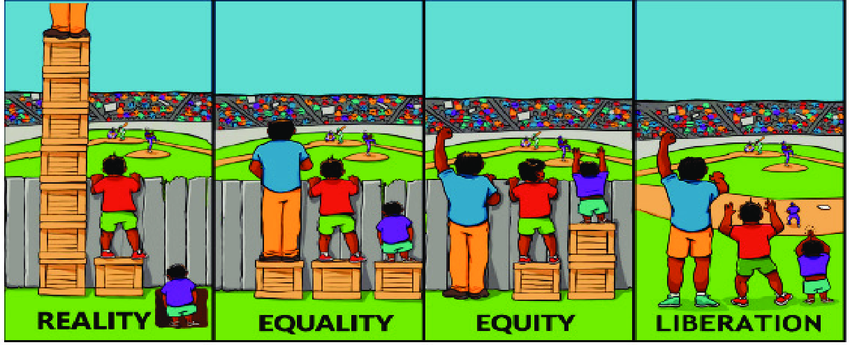
"When you're accustomed to privilege, parity and equity and equality may feel like oppression." --Ralph Warnock
In October, this column will look at the concept of "equity," --what it means, how it plays out in our lives, and how business can use it as a guiding principle in creating an inclusive workspace. Starting with an expanded version of an earlier column from last year that looked at the difference between equity and equality.
The Difference between "Equality" and "Equity"
People often used the words "equality" and "equity" interchangeably, but they mean different things. They are complementary concepts, not synonyms, and a business needs to pursue and nurture both to create a truly inclusive environment.
Equality means each individual or group of people is given the same resources or opportunities.
Equity recognizes that each person has different circumstances, and allocates the exact resources and opportunities needed to reach an equal outcome.
(International Women's Day)

Illustration credit via International Women's Day
Equity levels the playing field so that everyone has the opportunity to succeed. Organizations struggle to balance the need to maintain equality -- a set of rules and expectations for all their employees -- against the need to address inequity-- when those rules and expectations unfairly disadvantage some employees. When that balance is achieved, workplaces are happier, more diverse, more creative, and more productive.
Equity is therefore more focused on dismantling the obstacles that prevent people from participating fully and thus bringing all their talents and skill to the organiztion. "Dismantling obstacles" being those problems and structures that are systemic, such as requiring a 9-5 workday of all employees, instead of allowing for flexible scheduling for, say, single parents who need to arrange care for school aged children. Or giving staff Christmas off but not acknowledging other religious observances employees may practice. But also more insidious things such as penalizing a woman as "bossy" where a man would be considered to be demonstrating leadership. Or treating someone with a disability as a person to be "accommodated" instead of simply an employee with talent and potential.
Here's a good video from Jennifer Willey of Wet Cement of the 5 things businesses can do to "embrace equity" (the 2023 International Women's Day theme) and identify the inequitable practices in their workplace culture: Value talent based on talent.
Human Rights Careers offers some examples of how this balance plays out in common workplace scenarios just as the recruiting or hiring process, the way businesses determine salaries and raises, or what is meant by "reasonable accommodations." For example, it is an example of equality to require all people working the same job get the same pay. But if all the higher paying jobs in the organization are held by white people, and all the people of color in the organization only have lower paying jobs, then that organization has a problem with inequity that needs to be fixed. Immediately.